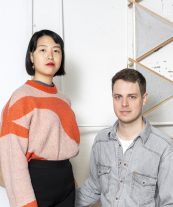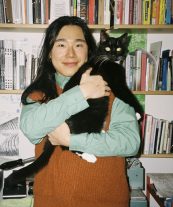COMMON GROUNDS: Cream on Chrome x Noam Youngrak Son
 1
1
 2
2
— ‘Designing interaction helps people get unstuck’
Cream on Chrome, founded by Martina Huynh and Jonas Althaus, designs socially engaged multimedia experiences that explore fresh perspectives. Awarded the DDA Young Designer title in 2022, they have selected Noam Youngrak Son–a communication designer whose work explores methods of disseminating deviating narratives–as their spotlight pick.
Noam: “Martina, you were my most relevant inspiration in choosing the communication department. I was especially inspired by your Basic Income Café project.”
Martina: “We were equally drawn to your activistic approach to design. I admire how you find topics that matter to you, and how you use metaphor to make them relatable, drawing people in.”
Jonas: “Your work is also quite outspoken and clearly takes a stance, like when you published a tool that converts images into Palestinian flag colors, in response to censorship on Instagram and other platforms. These interventions are witty and engaging, inviting us all to take part. We think our work is also political, but it’s more nuanced.”
Martina: “We strive to move beyond the mindset that design is primarily about fixing isolated problems. We feel this concept is failing: these small fixes have virtually no relevance if the planet is crumbling. It’s frustrating to have these many crises treated in isolation rather than part of a single ‘multicrisis’, where economic, social, democratic and ecological issues all converge. Our work has evolved into bringing together multiple domains.”
More-than-human
Martina: “At this year’s DDA expo we will be presenting the 2022 project “Forensic undergrowth”. Decades ago a large protest erupted in Amelisweerd over the construction of the A27 highway through their forest. Today, plans to expand the road have reignited the debate, and we wanted to offer a multi-vocal perspective on this hotly debated issue. We designed a more-than-human hearing where you can engage with five actors, each represented by a sculpture. When placed on a podium, a video testimony is activated. What might the trees have to say?”
Jonas: “The design proposed by landscape artists and engineers aimed to ‘smoothly’ integrate the highway into the forest, but that idea is quite laughable. It might look aesthetically less intrusive, but what does that mean for the bats or root systems disconnected in the process?”
Martina: “We recognise the necessity of including more-than-human voices into the discourse. With this installation we aim to foster a dialogue that embraces more perspectives.”
Jonas: “You’re ahead of us, Noam, in the way you’ve integrated more-than-humans into the process. That’s something we’d like to explore further–opening up our processes to a wider range of groups.”
Noam: “The work I’m presenting is titled “Towards the post-human idea of race as a viscous assemblage.” It examines the concept of race through a material lens. It focuses on melanin–the pigment that determines human skin colour–and MSG, the flavor enhancer often associated with Asian cuisine. I highlight the various technologies developed to inhibit the browning of plant bodies—a process linked to melanin production—within logistical systems. I also draw a connection between MSG and the lineage of Asian immigration in the United States, particularly how the food industry has been systemically oppressed by accusations regarding MSG—especially the claim of ‘Chinese restaurant syndrome’ which has led to violence. While the project originated from the observation that melanin is not only present in humans but in many species including fungi and plants, I aimed to avoid reducing the potential political implications of this observation into yet another bio-design project that fetishizes melanin. Instead, I attempted to explore what the presence of melanin in non-human bodies reveals about the concept of race and how this understanding could be extended to a deeper study of MSG.”
Audience
Noam: “I’ve been organizing a workshop called ‘Chimera Gastronomy’ for a few years now, and what intrigues me is that it’s been embraced in a variety of contexts, from museums to grassroots queer communities. While I particularly value certain communities, and I wish I could collaborate exclusively with them, I also question how the same work could obtain different political meanings when introduced to environments beyond my preferences. Sometimes the audience that attends my workshops is beyond my control, which creates tension. Those moments are when I truly recognize my role as a designer.”
Martina: “Those interactions are particularly interesting to pursue, despite their difficulty. I find that a well-designed interaction acts as a filter that helps people get unstuck.”
Jonas: “Or people just talk to someone with a different opinion, rather than seeking out messages that reinforce an existing view. In some cases, we activate an installation by performing a role within that space, which is incredibly rewarding as it allows us to connect directly with the audience.”
Noam: “My approach to these interactions is akin to that of a hacker, focusing on the open technical capacities of these environments. Institutions, while often stigmatized, are also forms of technology that remain fundamentally human. The essence of being a hacker is in recognizing this openness and leveraging it for your own purposes.”
Evelien Reich has served as chair of the Young Designer jury of Dutch Design Awards for the past three years. This year, she interviews the Young Designers that DDA has selected from the archives, as well as the emerging talents they choose to spotlight. All twenty Young Designers, both past and present, will showcase their work at the 2024 DDA exhibition during Dutch Design Week in Eindhoven, taking place 19 to 27 October.
Discover the work of Cream on Chrome and Noam Youngrak Son and all the other Young Designers of the Past & Present in the DDA24 exhibition at Microlab Hall on Strijp-S, during Dutch Design Week. From 19 to 27 October 2024 in Eindhoven.